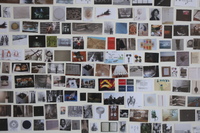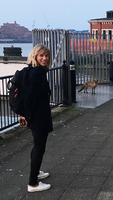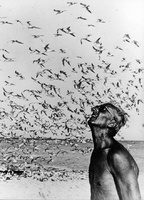Items
Site
The Medicine Chest
keywords is exactly
research
-

Taxonomy
Visually categorising a selection of my research material (accumulated since 2015). -

Nina Liebenberg
The researcher who conducted this study and wrote the dissertation, 'The Virus and the Vaccine: Curatorship and the Disciplinary Outsider '(2021). -

Hoard
"The chest was featured in a work titled 'Hoard', for which Bloch sculpted in clay the objects in the UCT collection as well as ones from the 11th century Mapungubwe collection (housed at the University of Pretoria). She painted these sculpted objects gold and presented them in museum display cases, drawing attention to the arbitrary nature of objects’ value and to the possibility that historically loaded items can be accidentally overlooked and misevaluated (Bloch in Honigman 2014: online)" (Liebenberg 2021: 82 - 84). -

Flight Patterns
Flight patterns observed on a bus en route back to London from Oxford on a research trip in 2017. -

Rice child (Stirrings)
"An object-study of a grain of rice by the artist Elaine Gan similarly shows the intermingling temporalities of humans, nonhumans and machines through an assemblage of images, text and vectors maps. Gan explores four temporalities within this research – the time of technologies, matter, memory and a calendar year – and installs the work as a long horizontal strip that cannot be viewed in full from a fixed position but encourages the viewer to walk ‘through time, occupy multiple positions’ and in so doing ‘trace new connections’ (Gan 2021). Time-travelling over two thousand years, Rice child (Stirrings) (2011) begins in the Mekong Delta, where the farming of champa rice facilitated the formation of stable settlements. It then follows a selection of rice varieties, revealing how they became technologies that accumulate socio-political formations, and weaves through the 2007/8 food crisis" (Liebenberg 2021: 28). -

Fishing rods over a bridge
Fishing rods over a bridge in Istanbul. -

Kimberlite
A display outside the Cape Town Diamond Museum in the V&A Waterfront -

Kimberlite
Kimberlite specimens, UCT Mantle Room -

Kimberlite
Kimberlite specimen, UCT Mantle Room -

The Diamond Mines of South Africa: Some Account of their Rise and Development.
“In the mines operated by the De Beers Company alone, more than eleven thousand African natives are employed below and above ground, coming from the Transvaal, Basutoland, and Bechuanaland, from districts far north of the Limpopo and the Zambesi, and from the Cape Colony on the east and the south to meet the swarms flocking from Delagoa Bay and countries along the coast of the Indian Ocean, while a few cross the continent from Damaraland and Namaqualand, and the coast washed by the Atlantic. The larger number are roughly classed as Basutos, Shanganes, M'umbanes, and Zulus, but there are many Batlapins from Bechuanaland, Amafengu, and a sprinkling of nearly every other tribe in South Africa” (Williams 1902: 412-413). -

The Diamond Mines of South Africa: Some Account of their Rise and Development.
“The initial impetus for establishing a collection of mantle materials for research purposes in South Africa was provided by Gardner Williams and his son Alpheus Williams in the late 19th and early 20th century. These two American mining engineers shared a great interest in the mining methods and geology of the South African kimberlite-hosted diamond mines they were supervising. Each wrote books on the subject and the two men assembled a collection of scientifically interesting rock samples and minerals from the mines. Subsequent to the death of Alpheus Williams, the Williams family donated this collection to the Geology Department at UCT for teaching and research purposes” (Department of Geological Sciences 2021). -

The Sea Birds of Isabella
Aired between 1968 and 1976, 'The Undersea World of Jacques Cousteau' was a documentary television series about underwater marine life. It was directed by Alan Landsburg and hosted by French filmmaker, researcher, and marine explorer Jacques Cousteau. In the 33rd episode of the series, titled 'The Sea Birds of Isabella', the crew journeys off the coast of Mexico to an island to study its tropical birds. Three years after it was shown, Cousteau's son, Phillipe (then aged 38) died trying to land his seaplane, called the Flying Calypso, on the Taos River in Portugal.


